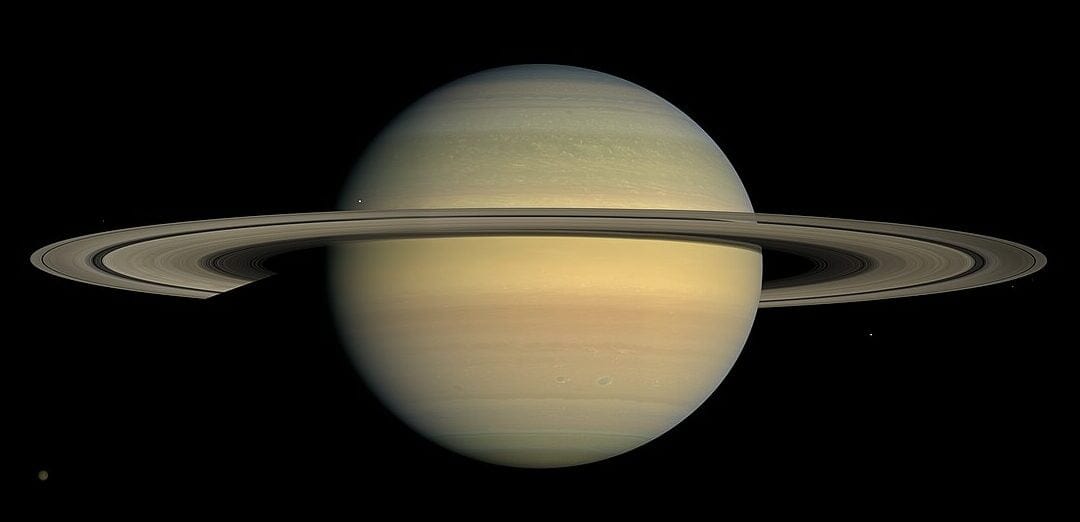Saturn, the sixth planet from the Sun, is part of the group of gas giants in our solar system, along with Uranus, Jupiter, and Neptune. This planet was named after the god of agriculture.
The majority of the planet consists of hydrogen, with small amounts of helium and traces of methane, water, ammonia, and heavier elements. In terms of its interior, there is a small core composed of nickel, iron, and ice, surrounded by a gaseous outer layer and a thin layer of metallic hydrogen. When observed from space, the outer atmosphere appears uniform and tranquil, although occasional long-term formations can be observed. Saturn possesses a planetary magnetic field that falls between the powerful field of Jupiter and Earth’s magnetic field in terms of strength. Wind speeds on the planet can reach up to 1800 km/hour, which is significantly higher than those on Jupiter.
Saturn possesses a noticeable ring system, primarily consisting of ice particles with a smaller amount of dust and heavy elements. Presently, there are 62 recognized satellites revolving around Saturn. Titan, the largest among them, ranks second in terms of size (following Ganymede).
In Saturn’s orbit, there exists an automated interplanetary station known as Cassini. It was launched by scientists in 1997 and, in 2004, successfully reached the Saturn system. Its objectives include the examination of the coleck’s structure as well as the dynamics of the magnetosphere and atmosphere.
The planet’s name
The planet Saturn was given its name in honor of the Roman god of agriculture. Later on, it was associated with the leader of the titans, Cronus. The Greeks did not hold Cronus in high regard due to his habit of devouring his own children, but the Romans respected and revered Saturn. According to ancient lore, Saturn taught humans how to cultivate the land, construct homes, and grow crops. This era, known as the “Golden Age of Mankind,” was said to coincide with Saturn’s reign, and festivities called Saturnalia were held in his honor. During these celebrations, slaves were granted temporary freedom. In Indian mythology, the planet is linked to Shani.
Origin of Saturn
It is important to note that the origin of Saturn is accounted for by two primary theories (similar to Jupiter). The “concentration” theory suggests that Saturn and the Sun share a similar composition due to their high hydrogen content. This low density is attributed to the formation of massive “clumps” in the gas-dust disk during the early stages of the solar system’s development, which ultimately gave rise to the planets. Therefore, it can be inferred that both the planets and the Sun were formed through a similar process. However, this theory does not provide an explanation for the differences in composition between the Sun and Saturn.
The theory of “accretion” suggests that Saturn’s formation occurred in two stages. Initially, over a span of two hundred million years, solid dense bodies similar to the planets in the Earth group formed. During this stage, some gas dissipated from the regions of Saturn and Jupiter, leading to differences in the chemical compositions of the Sun and Saturn. Subsequently, the second stage commenced, during which the largest bodies grew to twice the mass of the Earth. Over several hundred thousand years, gas accretion from the primary protoplanetary cloud occurred, adding to these bodies. In the second stage, temperatures in the outer layers of the planet reached 2000°C.
Saturn in comparison to other planets
As previously mentioned, Saturn is classified as a gas planet, meaning it lacks a solid surface and is primarily composed of gases. It has a polar radius of 54,400 km and an equatorial radius of 60,300 km. Among the other planets, Saturn stands out for its high level of compression. Despite weighing 95.2 times more than Earth, Saturn’s average density is actually lower than that of water. Interestingly, while Saturn and Jupiter differ significantly in mass, their equatorial diameters only differ by 19%. In contrast, the other gas planets have much higher densities, ranging from 1.27-1.64 g/cm3. The free fall acceleration along Saturn’s equator is 10.44 m/s2, which is comparable to that of Neptune and Earth, but much lower than Jupiter’s.
Rotation and orbital characteristics of Saturn
Saturn has an average distance of 1430 million km from the Sun. The planet orbits the Sun with a speed of 9.69 km/s, completing one orbit every 29.5 years (10,759 days). The distance between Saturn and Earth varies between 8.0 astronomical units (119 million km) and 11.1 astronomical units (1660 million km), with an average distance of 1280 million km during their opposition. At aphelion and perihelion, Saturn is approximately 162 million km away from the Sun. It is interesting to note that Jupiter and Saturn are in a nearly exact 2:5 resonance with the Sun during these points in their orbits.
The planet’s atmosphere exhibits a differential rotation pattern that is reminiscent of the atmospheres of Venus, Jupiter, and even the Sun. It was A. Williams who initially observed that the rotation rate of Saturn can fluctuate not just in depth and latitude, but also over time. A comprehensive examination of the equatorial rotation’s variability over a span of 200 years revealed that the primary drivers of this variability are the annual and semi-annual cycles.
Saturn’s Atmospheric Composition and Structure
Saturn’s upper atmosphere is predominantly composed of 96.3% hydrogen and 3.25% helium. Additionally, it contains trace amounts of ammonia, methane, ethane, phosphine, and various other gases. Notably, the ammonia clouds in Saturn’s upper atmosphere are more prominent compared to those found on Jupiter. In the lower part of Saturn’s atmosphere, the clouds consist of water or ammonium hydrosulfide.
Based on data from Voyager, it has been observed that the planet experiences robust wind patterns. The instruments utilized were able to measure wind speeds of up to 500 m/s. These winds primarily blow in an eastern direction, although as you move further away from the equator, their intensity gradually decreases (with the possibility of western atmospheric currents emerging). Research has indicated that atmospheric circulation can occur both in the upper cloud layer and at depths of up to 2000 km. Additionally, measurements from Voyager-2 have revealed that the winds in the northern and southern hemispheres are symmetrical in relation to the equator. It is theorized that these symmetrical flows may have a connection beneath the visible atmospheric layer.
From time to time, there are stable formations in the atmosphere of Saturn that manifest as incredibly powerful hurricanes. Similar phenomena can also be found on the other gas planets in our solar system. Approximately every 30 years, a phenomenon known as the “Great White Oval” appears on Saturn, with its most recent occurrence observed in 2010 (these large hurricanes are not formed with such frequency).
During storms and tempests on Saturn, there are intense lightning discharges. The electromagnetic activity resulting from these discharges varies over time, ranging from barely noticeable to extraordinarily powerful electrical storms.
On December 28, 2010, the Cassini spacecraft captured an image of a storm that resembled smoke from a cigarette. Astronomers recorded another powerful storm on May 20, 2011.
Structure inside
Deep within the atmosphere of the planet, the temperature and pressure are on the rise, causing hydrogen to undergo a gradual transition into a liquid state. It is at a depth of 30,000 kilometers that hydrogen becomes metallic, under a pressure of 3 million atmospheres. This transition gives rise to the creation of a magnetic field, which is generated by the circulation of electric currents within the metallic hydrogen. However, this magnetic field is not as strong as that of Jupiter. Located in the central region of the planet is a dense core comprised of heavy, solid materials such as metals, silicates, and potentially ice. This core weighs approximately 9 to 22 times the mass of our own planet and maintains a scorching temperature of 11,700°C. It is worth noting that Saturn emits an impressive amount of energy into space, which is two and a half times greater than the energy it receives from the Sun. A significant portion of this energy is generated through the Kelvin-Helmholtz mechanism. As the temperature drops, so does the pressure within the core, resulting in the conversion of energy into heat. However, it is believed that this mechanism alone cannot account for all of Saturn’s energy. Scientists propose that an additional source of heat is derived from the condensation and subsequent descent of helium droplets through the layer of hydrogen and into the core. As a result, the potential energy of these droplets is converted into thermal energy. According to scientific estimates, the core region has a diameter of approximately 25,000 kilometers.
Saturn’s Moons
The largest moons of Saturn include Enceladus, Mimas, Dione, Tefia, Titan, Rhea, and Japetus. These moons were initially discovered in 1789 and continue to be the primary focus of scientific research. Their sizes range from 397 to 5150 km in diameter. The distribution of masses corresponds to the distribution of diameters. Tefia and Dione have the least elliptical orbits, while Titan has the most elliptical orbit. All moons with known parameters orbit above the synchronous orbit, resulting in their gradual drift away from Saturn.
As of 2010, there were a total of 62 known satellites orbiting Saturn. Out of these, 12 were discovered through the use of spacecraft such as Cassini, Voyager 1, and Voyager 2. With the exception of Phebe and Hyperion, most of these satellites exhibit synchronous rotation, meaning that they always have one side facing towards Saturn. Unfortunately, there is no available information regarding the rotation of the smaller satellites. Additionally, Dione and Tefia are accompanied by two satellites each at the Lagrangian points L4 and L5.
In 2006, a group of scientists led by David Jewett conducted a thorough research in Hawaii using the Subaru telescope, which led to the identification of nine irregular satellites of Saturn. These satellites are characterized by having a retrograde orbit, and their time of rotation around Saturn ranges from 862 to 1300 days.
It was not until 2015 that the first high-quality images of one of the Tefia satellites were obtained.
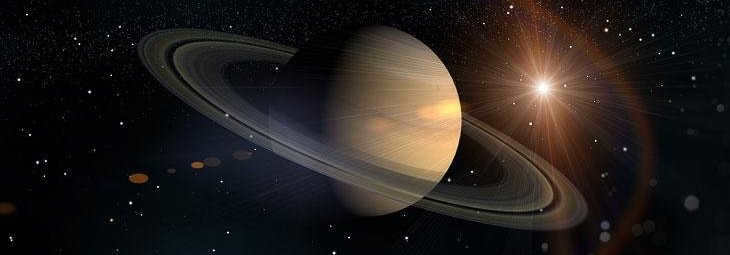

Saturn, a planet adorned with rings, is undoubtedly one of the most captivating astronomical objects to observe. It is hard to dispute this fact after gazing at the ringed giant through a telescope. However, Saturn is not only interesting from an aesthetic standpoint.
Astrophysicists and astronomers are still grappling with the questions of why the sixth planet from the Sun has a system of rings and how it acquired such a luminous feature.
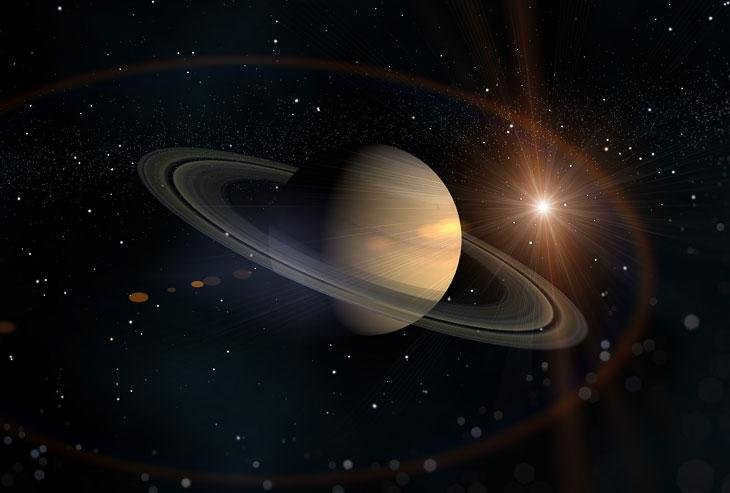

Concise description of Saturn
Saturn, like other gas giants in our vicinity of space, holds great interest for the scientific community. The distance from Earth to Saturn ranges from 1.20 to 1.66 billion kilometers. It would take a little over two years for a spacecraft launched from our planet to traverse this vast distance. The most recent automated probe, known as “New Horizons,” arrived at the sixth planet after two years and four months. It is important to note that Saturn’s orbit around the Sun closely resembles the orbital motion of Earth. In other words, Saturn’s orbit takes the shape of a perfect ellipse. It has the third highest orbital eccentricity, following Mercury and Mars. At its closest point to the Sun, known as perihelion, Saturn is located 1,353,572,956 kilometers away, while at its farthest point, known as aphelion, the gas giant is slightly further at 1,513,325,783 kilometers.
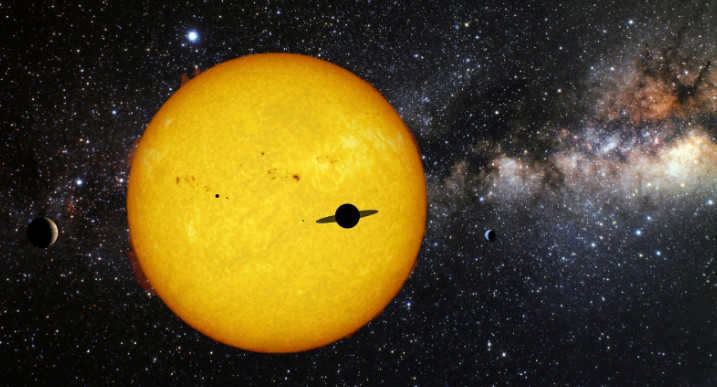

Even though it is located far away from the central star, the sixth planet, Saturn, exhibits a remarkable behavior by rotating around its own axis at an astonishing speed of 9.69 km/s. Saturn completes one rotation in 10 hours and 39 minutes, making it the second fastest rotating planet after Jupiter. Due to its rapid rotation, Saturn appears flattened at the poles, resembling a wolf spinning rapidly through space at a speed of 9.89 km/s. It takes Saturn approximately 30 Earth years to complete one revolution around the Sun. Ever since Galileo discovered Saturn in 1610, the planet has completed 13 orbits around the main star of our solar system.
The celestial body is visible as a relatively luminous point in the nocturnal expanse, displaying an apparent magnitude that varies between +1.47 and -0.24. The brilliant rings of Saturn, possessing a high albedo, are particularly prominent.
The positioning of Saturn within the cosmic realm is equally intriguing. The planet’s rotational axis exhibits an inclination to the ecliptic axis that closely resembles that of Earth. As a result, the gas giant experiences distinct seasons.
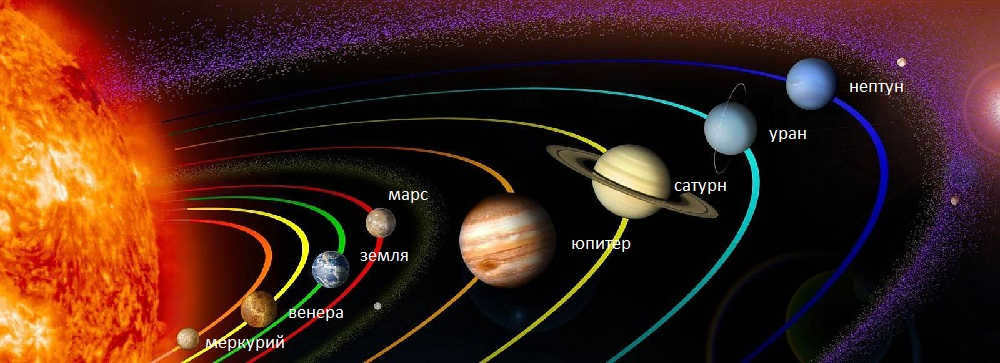

While Saturn is not the largest planet in the solar system, it is still a significant celestial body, ranking as the second largest after Jupiter. In terms of size, Saturn has an average radius of 58,232 kilometers, which is smaller than Jupiter’s radius of 69,911 kilometers. Interestingly, Saturn’s polar diameter is smaller than its equatorial diameter. In terms of mass, Saturn is incredibly massive, with a weight of 5.6846-10²⁶ kg, which is 96 times the mass of Earth.
The planets closest to Saturn are its planetary siblings, Jupiter and Uranus. Jupiter is categorized as a gas giant, while Uranus is classified as an ice giant. Both Jupiter and Saturn are known for their immense mass and low density, as they are massive globes of liquefied gas. Saturn has a density of 0.687 g/cm³, making it the second least dense planet in the entire Solar System.
In contrast, the terrestrial planets in our solar system, including Mars, Earth, Venus, and Mercury, have much higher densities. Mars has a density of 3.94 g/cm³, Earth has a density of 5.515 g/cm³, Venus has a density of 5.25 g/cm³, and Mercury has a density of 5.42 g/cm³.
Description and composition of Saturn’s atmosphere
The concept of a planetary surface is not applicable to Saturn, as it lacks a solid terrestrial structure. It is believed that the “surface” of this sixth planet consists of a hydrogen-helium ocean, where the intense pressure causes the gas mixture to transition into a semi-liquid and liquid state. Due to the lack of technical capabilities, the exploration of Saturn’s surface remains purely theoretical. However, scientists have focused their studies on Saturn’s atmosphere, which acts as a dense blanket surrounding the planet.
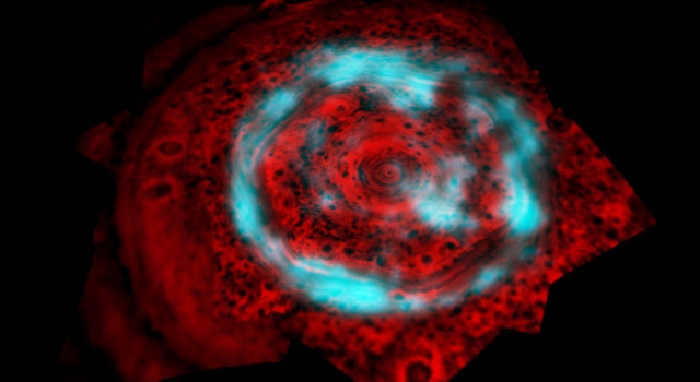

The planet’s atmospheric shell is primarily composed of hydrogen. It is the presence of hydrogen and helium that causes constant movement within the atmosphere. This can be observed through the formation of significant cloud structures, which are made up of ammonia. The inclusion of small sulfur particles within the air-gas mixture gives Saturn its distinct orange hue from the outside. The region of dense cloud cover starts at the lower boundary of the troposphere, approximately 100 km above the planet’s hypothetical surface. Within this area, temperatures can range between -200 to -250 degrees Celsius.
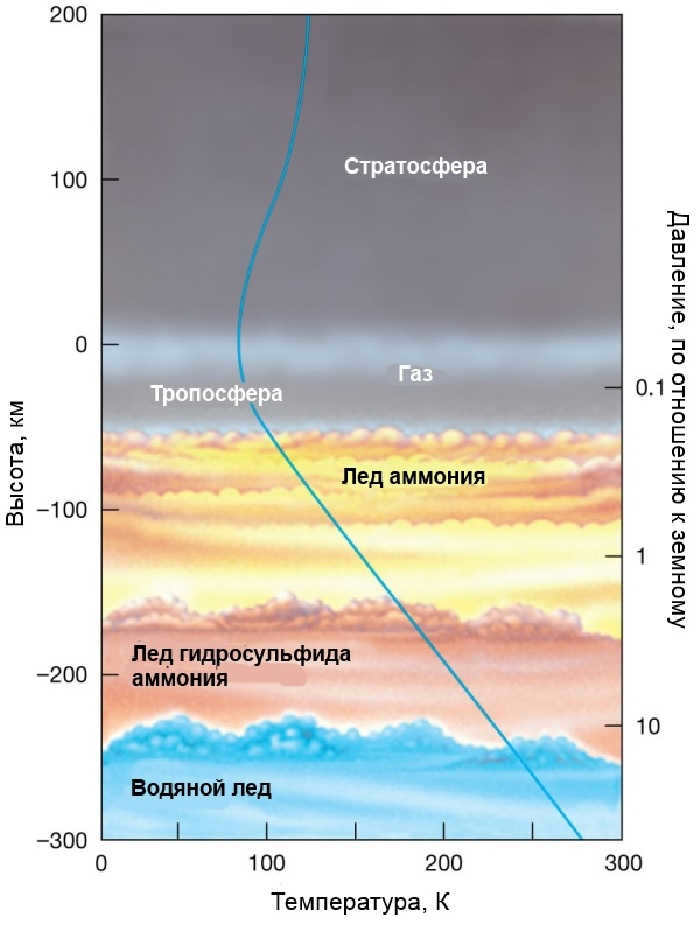

Here are more accurate figures regarding the atmospheric composition:
- Hydrogen accounts for 96%;
- Helium makes up 3%;
- Methane comprises only 0.4%;
- Ammonia makes up 0.01%;
- Molecular hydrogen accounts for 0.01%;
- Ethane accounts for 0.0007%.
Saturn’s cloud cover is characterized by its density and massiveness, which appears to be more powerful than that of Jupiter. In the lower atmosphere, the primary components of Saturn’s cloud cover consist of varying forms of ammonium hydrosulfite or water. The presence of water vapor in the lower regions of Saturn’s atmosphere, below 100 km in altitude, can be attributed to the temperature, which remains below absolute zero in this area. The atmospheric pressure in the lower parts of the atmosphere measures around 140 Kpa. As we descend towards the surface of this celestial body, both the temperature and pressure increase. Gaseous compounds undergo transformations to adopt new forms. Due to the high pressure, hydrogen adopts a semi-liquid state. It is estimated that the average temperature at the surface of Saturn’s hydrogen-helium ocean is approximately 143K.
The unique state of the air-gas shell is what sets Saturn apart from the other planets in our solar system, as it emits more heat into space than it absorbs from the Sun.
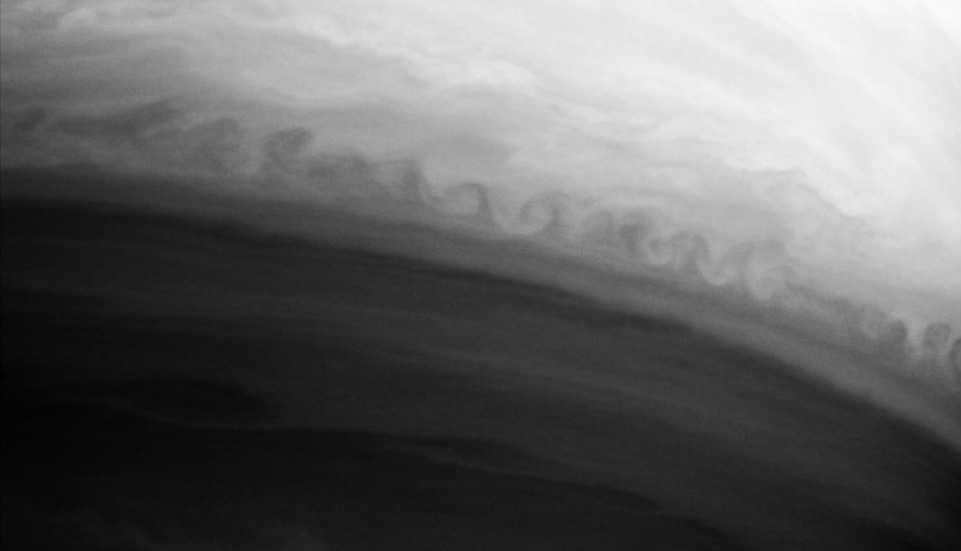

Saturn, located at a distance of one and a half billion kilometers from the Sun, receives only one hundredth of the solar heat that the Earth receives.
The source of Saturn’s heat is attributed to the Kelvin-Helmholtz mechanism. As the temperature decreases, the pressure in the planet’s atmospheric layers also decreases. This causes the celestial body to naturally contract, converting the potential energy of compression into heat. Another hypothesis that explains the intense heat release from Saturn is a chemical reaction. Due to convection in the atmosphere layers, there is condensation of helium molecules within the hydrogen layers, which results in the release of heat.
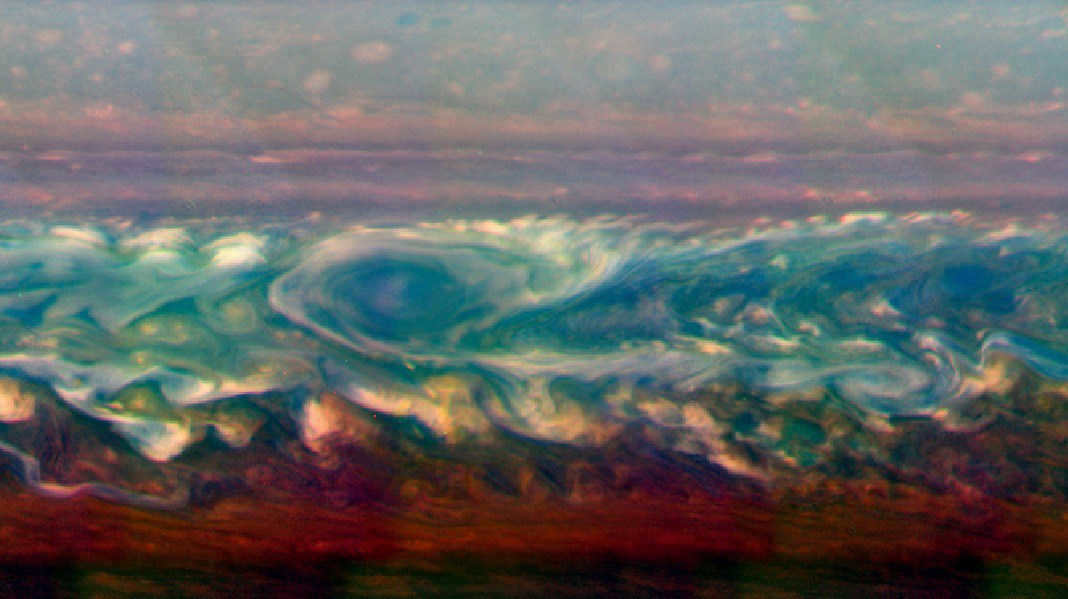

The presence of dense masses of clouds and temperature variations in the atmospheric layers make Saturn one of the most turbulent regions in the entire solar system. Storms and hurricanes on this planet are significantly stronger and more powerful compared to those on Jupiter. The speed of the air currents can reach astonishing values of up to 1800 km/h. Additionally, Saturnian storms develop rapidly, with the formation of a hurricane on the planet’s surface observable within a few hours through a telescope. However, after the initial formation, a prolonged period of chaotic cosmic activity ensues.
The composition of the planet and an overview of its core
As temperature and pressure rise, hydrogen undergoes a gradual transition into a liquid state. At a depth of approximately 20-30 thousand kilometers, the pressure reaches 300 GPa, leading to the metallization of hydrogen. Moving deeper into the planet’s interior, the proportion of hydrogen oxide compounds increases. The outer layer of the core consists of metallic hydrogen, which creates highly intense electric currents and generates a powerful magnetic field.
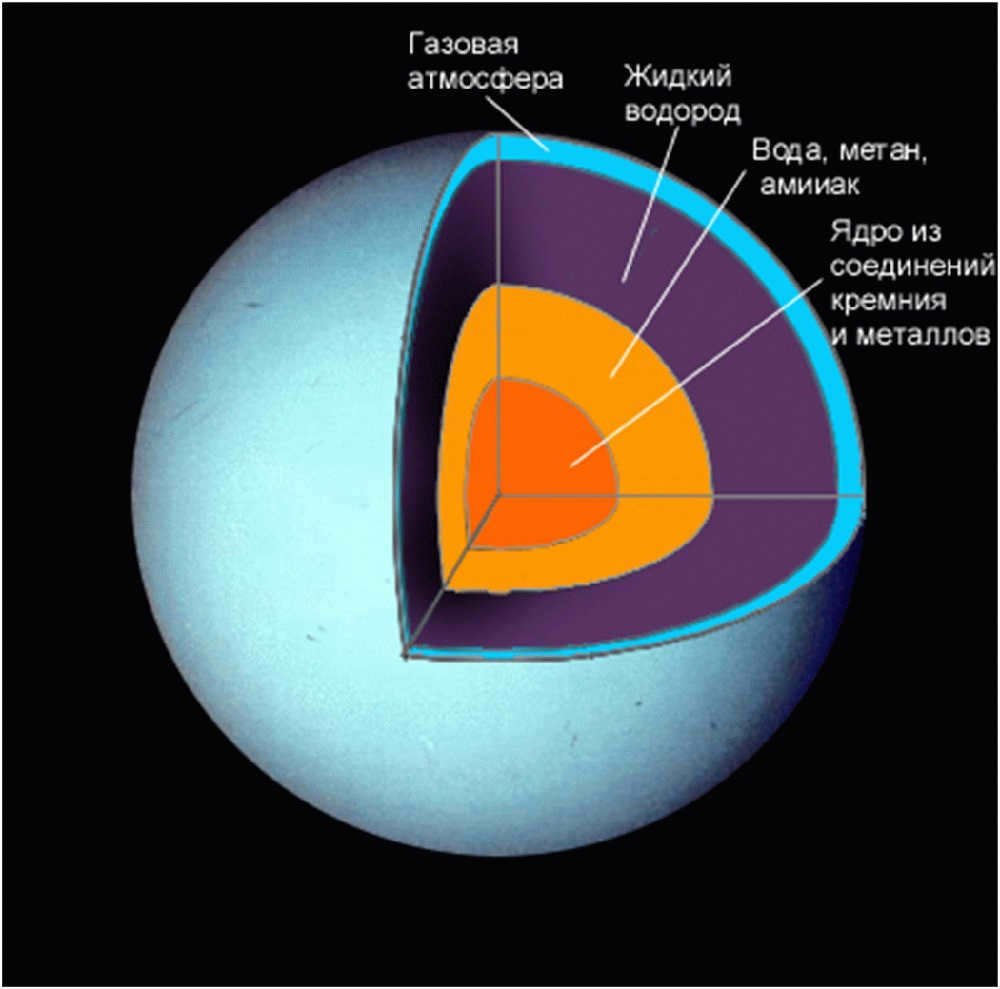
Different from the external layers of Saturn, the central section of the core is a colossal structure measuring 25 thousand kilometers in diameter, composed of silicon and metallic compounds. It is believed that temperatures in this area can reach up to 11,000 degrees Celsius. The mass of the core fluctuates between 9-22 times that of our planet.
Saturn’s system of moons and rings
Saturn possesses a total of 62 moons, with many of them boasting solid surfaces and even their own atmospheres. In terms of size, some of these moons can make a case for being considered planets themselves. Take Titan, for instance, which happens to be one of the largest moons in the entire solar system and is actually larger than the planet Mercury. This celestial body, which orbits around Saturn, boasts a diameter of 5150 km. What makes it even more remarkable is the fact that it has its very own atmosphere, which happens to closely resemble the early stages of Earth’s own atmospheric composition.
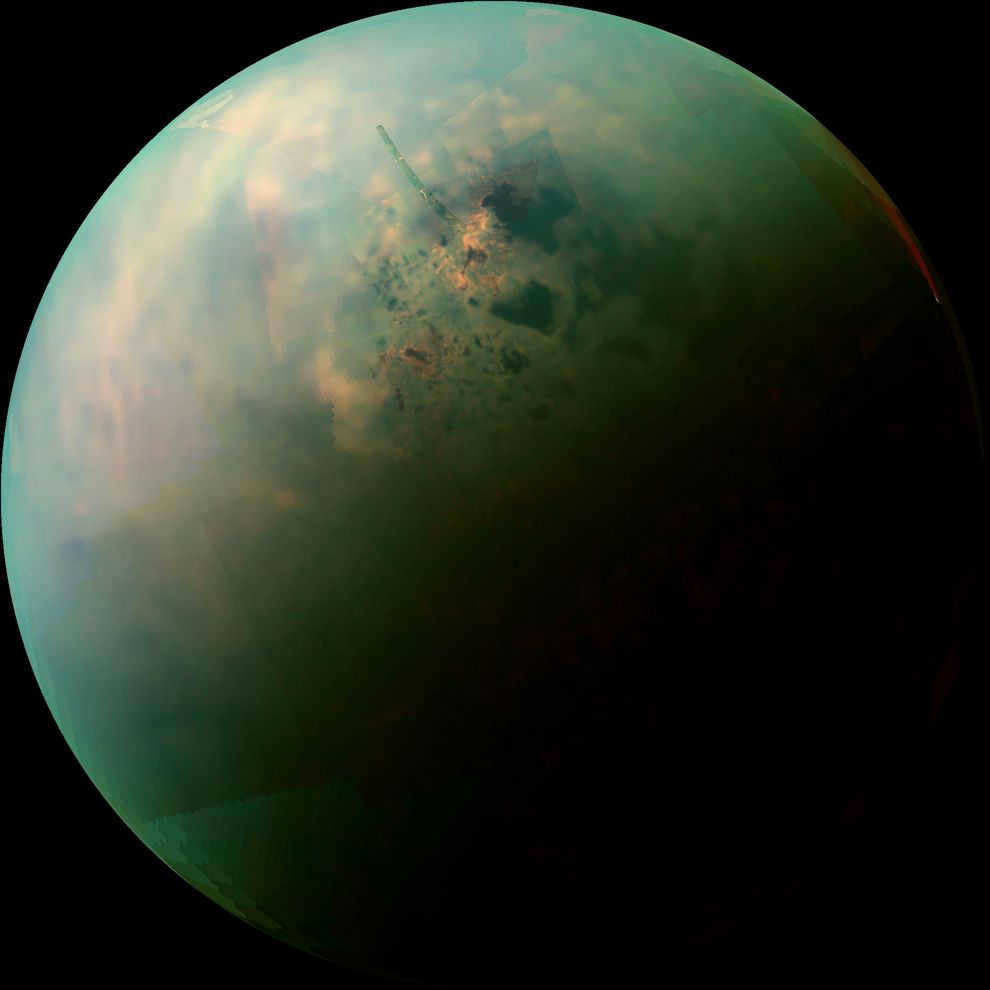

Scientists have a belief that Saturn possesses the most advanced system of satellites in the entire solar system. Information gathered from the Cassini spacecraft suggests that Saturn is one of the few places in the solar system where liquid water can potentially exist on its satellites. Although only a few of the ringed giant’s satellites have been explored so far, the available data already provides compelling evidence that this distant region of space may be suitable for supporting certain life forms. Consequently, the fifth satellite – Enceladus, has generated significant interest among scientists and astrophysicists.
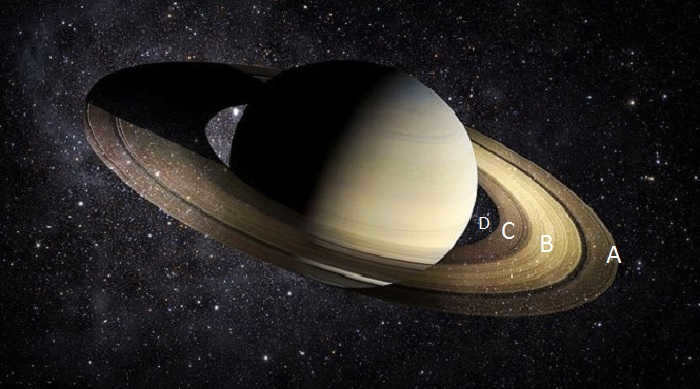

The primary adornment of Saturn is undoubtedly its rings. In the system, there are four main rings, known as A, B, C, and D. The largest ring, B, has a width of 25,500 km. These rings are separated by gaps, with the largest one being the Cassini division, which separates the A and B rings. The rings of Saturn consist of clusters of small and large particles made of water ice. Because of their icy composition, Saturn’s rings have a high albedo, making them easily visible through a telescope.
Summing up
Scientific and technological progress in the last three decades has enabled scientists to conduct more extensive research on the remote planet using advanced tools and equipment. Since the initial data collected by the American spacecraft Pioneer 11 during its historic flyby of Saturn in 1979, scientists have been able to closely examine and study this gas giant in great detail.
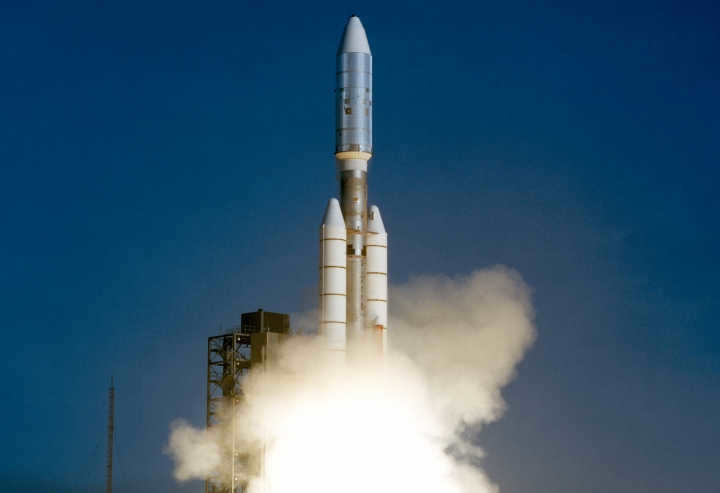

The exploration mission in the early 80s, known as “Pioneer”, was followed by two missions called “Voyager”, the first and second. The main focus of the research was on the moons of Saturn. In 1997, humans received a significant amount of information about Saturn and its system through the Cassini-Huygens mission. The mission program included a planned landing of the Huygens probe on the surface of Titan, which was successfully accomplished on January 14, 2005.
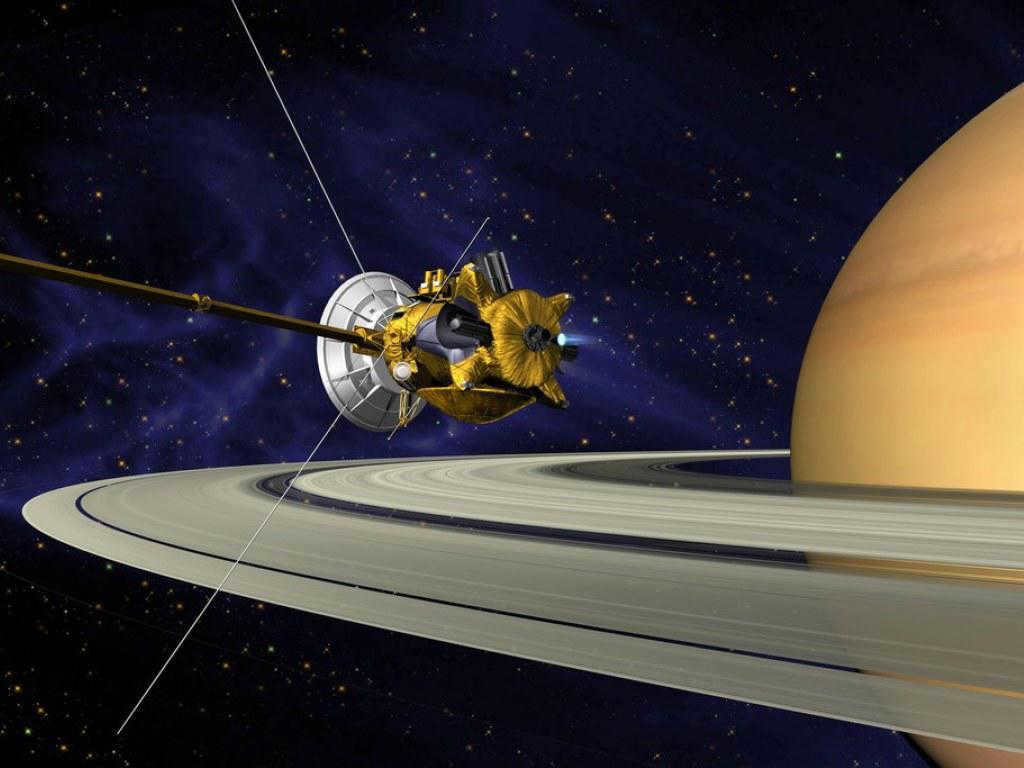

The exploration of the sixth planet in the solar system reached a milestone with the Cassini mission.
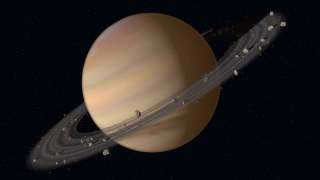

Saturn is positioned as the sixth planet from the Sun in our solar system, and it takes second place in terms of size when considering mass and diameter. A noteworthy fact is that Saturn has a close relative in our solar system, almost like a sibling – Jupiter. They both have a similar atmosphere and rotation characteristics. It is due to this resemblance that Saturn earned its name in honor of its father figure, Jupiter.
When it comes to the planetary system, Saturn is absolutely impossible to overlook. One factor that sets it apart is its magnificent rings, which outshine the ring systems of other planets. These rings are not only the largest, but they are also widely regarded as the most stunning. Until recently, this gas giant remained largely unexplored. However, thanks to the Cassini spacecraft, scientists from all around the globe now have the opportunity to gather daily data about this planet through nearly continuous observations.
Saturn is among the five planets that can be observed from Earth by anyone without the need for specialized equipment. Additionally, this celestial body ranks as the fifth brightest in the entire system.
Discovery History
The discovery of Saturn cannot be attributed to a specific individual as it can be observed from Earth without the need for a telescope, and visually, it appears similar to other stars. Therefore, it is impossible to accurately determine who first identified the planet.
The ancient Babylonians were among the first to observe Saturn, but it was not until 1609 that Galileo became the first scientist to study it using an optical device. However, due to the limitations of the technology at the time, Galileo mistook the planet’s protrusions and irregularities for separate and distinct objects that were later not found.
Telescopic observations of the planet reveal that it has a pale yellow appearance. This is due to the presence of ammonia particles in its upper atmospheric layers. Below these layers, there are clouds composed of frozen water crystals. Further down, there are layers consisting of cold mixtures of sulfur and hydrogen.
Scientists classify Saturn as a gas giant, although there is a hypothesis suggesting the existence of a solid, rock-like core surrounded by a hydrogen and helium environment.
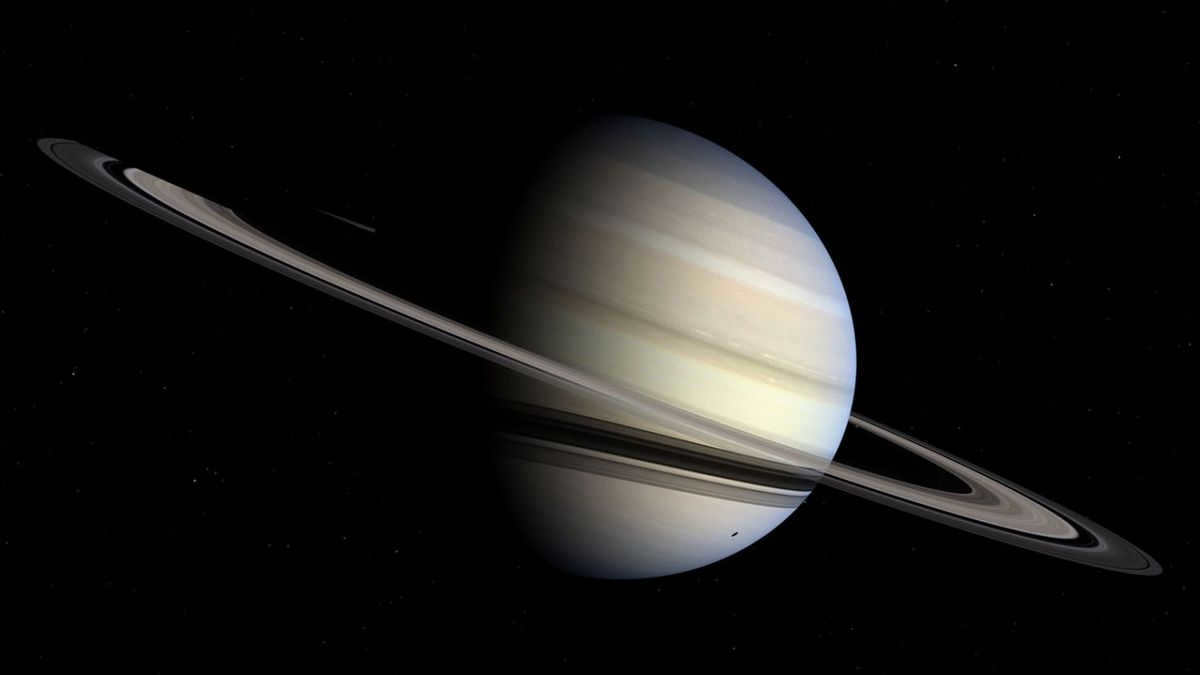

Distinctive Features of the Planet
When comparing Saturn to Jupiter, it falls short in terms of diameter (120 and 143 thousand kilometers, respectively), size (Jupiter is 1.18 times larger), and mass (Saturn is almost four times lighter than Jupiter).
Saturn’s lightness is not only due to its size. In fact, if it were placed in water, it would effortlessly float on the surface like a ball. The gravity of this celestial body is 91 percent of that of Earth.
Furthermore, this giant planet greatly differs from our home planet in terms of size (almost 9 and a half times) and mass (95 times). Approximately 763 Earths could fit inside this object.
- The equatorial radius measures 60,268 kilometers (with a margin of error of 4 km).
- The polar radius is 54,364 km (with a margin of error of 10 km).
- The surface area is 4.272⋅1010 km 2
- Volume – 8.2713⋅1014 km 3
- Mass – 5.6846⋅1026 kg
- Rotational speed – 10 hours 32 minutes 45 seconds (error 46 seconds)
- There are rings
Planetary exploration
Starting in 1609, Galileo Galilei observed the planet. After fifty years, the Dutch mathematician and astronomer Huygens, using more advanced equipment, discovered that the objects referred to as Saturn’s “companions” by Galileo are actually a flat solid ring surrounding the planet, not in contact with it. Huygens is also credited with the detection of Titan.
Since 1675, the Franco-Italian astronomer Cassini has been continuously observing the planet. He was the one who realized that the ring is not uniform, but consists of two rings. The space between them is known as the Cassini gap. He also discovered Japetus, Tefia, Dione, and Rhea.
The first spacecraft to reach Saturn was the “Pioneer” in 1979. It successfully transmitted the first images of the outer rings, the surface of the giant planet, and discovered its powerful magnetic field. The Voyager spacecraft followed, confirming the existence of multiple rings and identifying nine satellites.
Subsequently, a second “Pioneer” and a second “Voyager” mission were launched to explore Saturn. Since 2004, the “Cassini” probe has been continuously orbiting the planet, conducting observations and collecting data.
Scientists believe that Saturn formed approximately five million years ago. To travel from Earth to Saturn, any spacecraft must cover a distance of 1,430,000,000 kilometers.
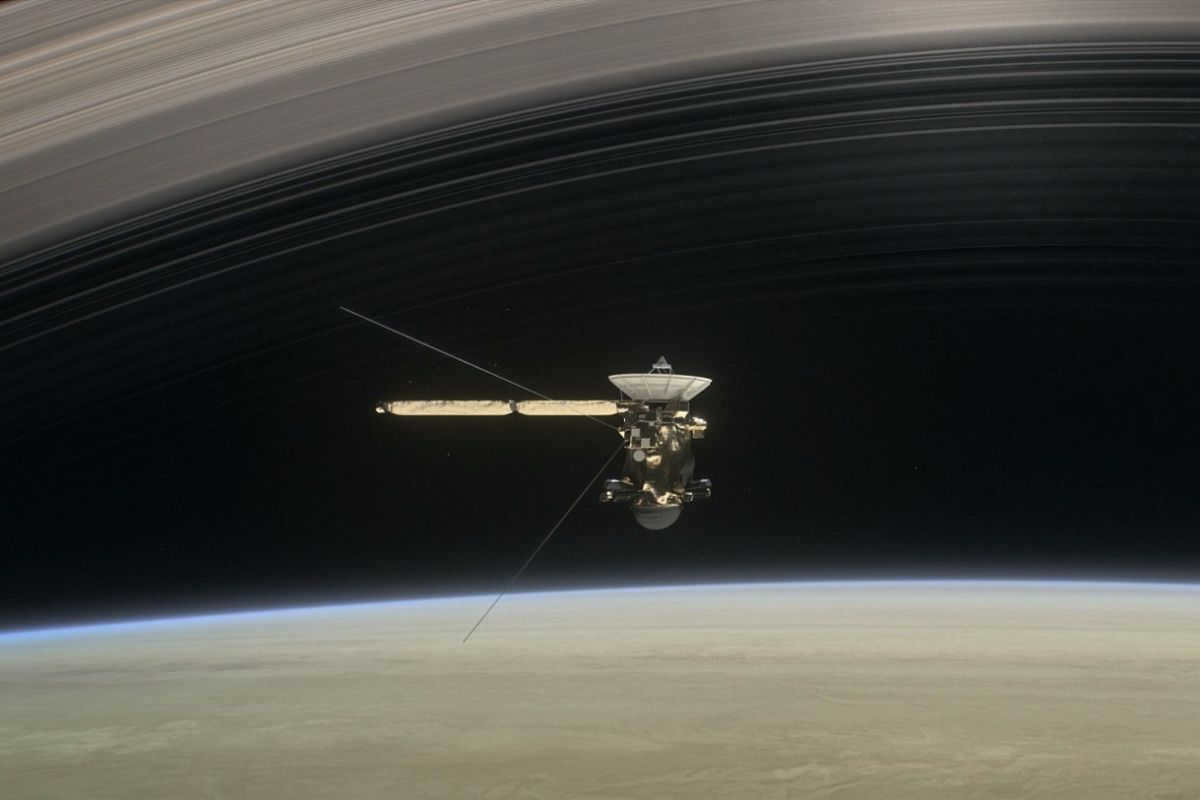

Movement
The seasonal patterns on Saturn closely resemble those on Earth, although the distinction between them is more indistinct despite Saturn’s 27-degree axial tilt, which is similar to Earth’s. However, Saturn receives less sunlight due to its greater distance from the sun, resulting in less defined seasonal boundaries.
Saturn has a rotational period of just over 10.5 hours, making it slightly slower than the fastest planet in the solar system, Jupiter. This rapid rotation has had a significant impact on Saturn’s shape, causing it to become oblate. As a result, Saturn exhibits noticeable bulges at its equator.
The giant planet Saturn also possesses another intriguing characteristic: its observable latitudes rotate at varying speeds. This phenomenon can be attributed to the fact that Saturn’s interior is primarily composed of gas rather than solid material, which is inherently unstable.
In terms of its orbital period, Saturn completes a full revolution around the Sun in approximately 29 Earth years. This relatively lengthy duration earned the planet the ancient Assyrian moniker “Lubadsagush,” which translates to “the oldest of the old.”
Composition and Structure of Saturn’s Atmosphere
The composition of Saturn’s atmosphere is primarily made up of hydrogen, which accounts for ninety-six percent, and helium, which accounts for four percent. These two main elements are blended with small amounts of ammonia, ethane, acetylene, methane, and phosphine. The atmosphere has a total thickness of 60 kilometers.
The winds on Saturn are the fastest in the entire solar system, reaching speeds of up to 1800 kilometers per hour. Three distinctive phenomena can be observed in Saturn’s atmosphere: the presence of northern lights, clouds that form horizontal stripes, and a hexagonal-shaped vortex known as the Black Vortex.
As you move closer to the equator, the width of the cloud bands increases, but they become narrower as you approach the poles. It wasn’t until Voyager explored Saturn in 1970 that scientists discovered the presence of streaky clouds on the planet. Nowadays, anyone with good optical equipment can observe these clouds from any location on Earth.
Another fascinating phenomenon on Saturn is the hexagonal storm vortex known as Black. Despite extensive research, scientists have yet to fully understand this phenomenon. It shares similarities with Jupiter’s Great Red Spot, but it has a much shorter duration. After observing these storms for several decades, scientists have determined that they appear periodically, once per full orbital revolution.
It’s worth noting that Saturn’s magnetic field is weaker than Earth’s, measuring only one-twentieth of Jupiter’s magnetic field.
Saturn has the ability to emit more energy than it receives from the Sun. This is because of the gravitational compression and friction occurring within its atmosphere, specifically with the helium present.
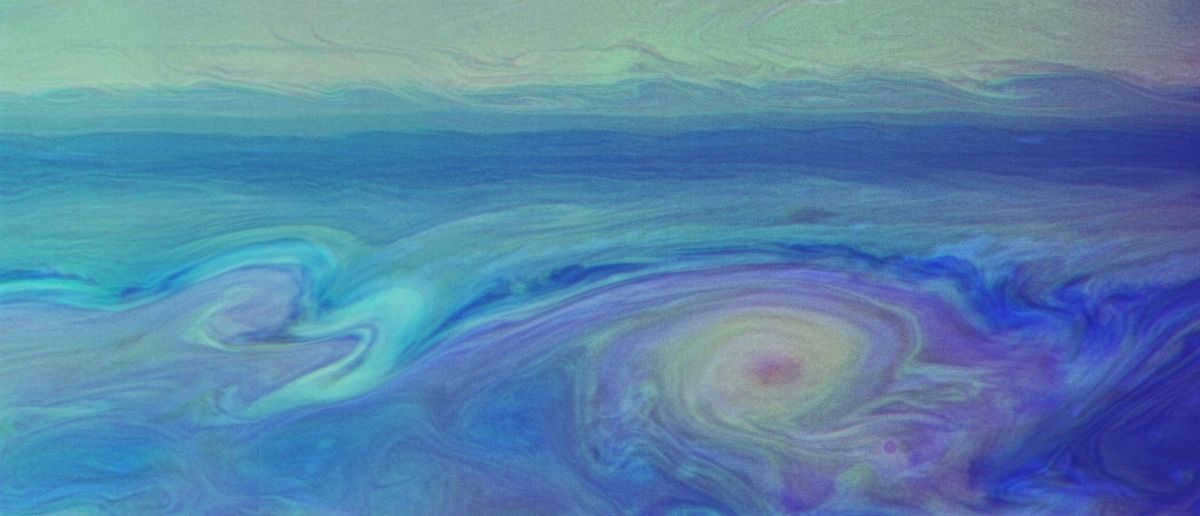

Satellites
As of 2010, there were 62 known satellites orbiting around Saturn, with 12 of them being discovered during the first and second expeditions of Voyager and Cassini. Since then, over 150 satellites have been discovered. Seven of the largest satellites were actually discovered back in 1789. The diameters of these “big seven” range from 397 kilometers (Mimas) to 5150 kilometers (Titan).
Titan is truly deserving of its name, as it is not only the largest moon of the planet, but also the second largest in the entire solar system after Jupiter’s moon Ganymede. This impressive celestial body is composed of a combination of water ice and rock. Its atmosphere is cloudy and consists of a mixture of nitrogen, methane, and ethane. Titan’s diameter is 50 percent larger than that of the moon. While it is larger than Mercury, it is still smaller than the planet in terms of mass.
With the exception of Theba and Hyperion, most of Saturn’s moons orbit independently and synchronously, always keeping the same side facing towards Saturn.
Scientists speculate that there may be aquatic life forms living beneath a thick layer of ice on Enceladus and Titan. However, these organisms are likely to be very different from the microorganisms found on Earth.
Japte, the satellite, is remarkable for its extraordinary beauty: one side of this object is entirely black while the other side is entirely white. Tephea is adorned with stunning craters on its surface, while Atlas and Pan bear a striking resemblance to UFOs – flying saucers.
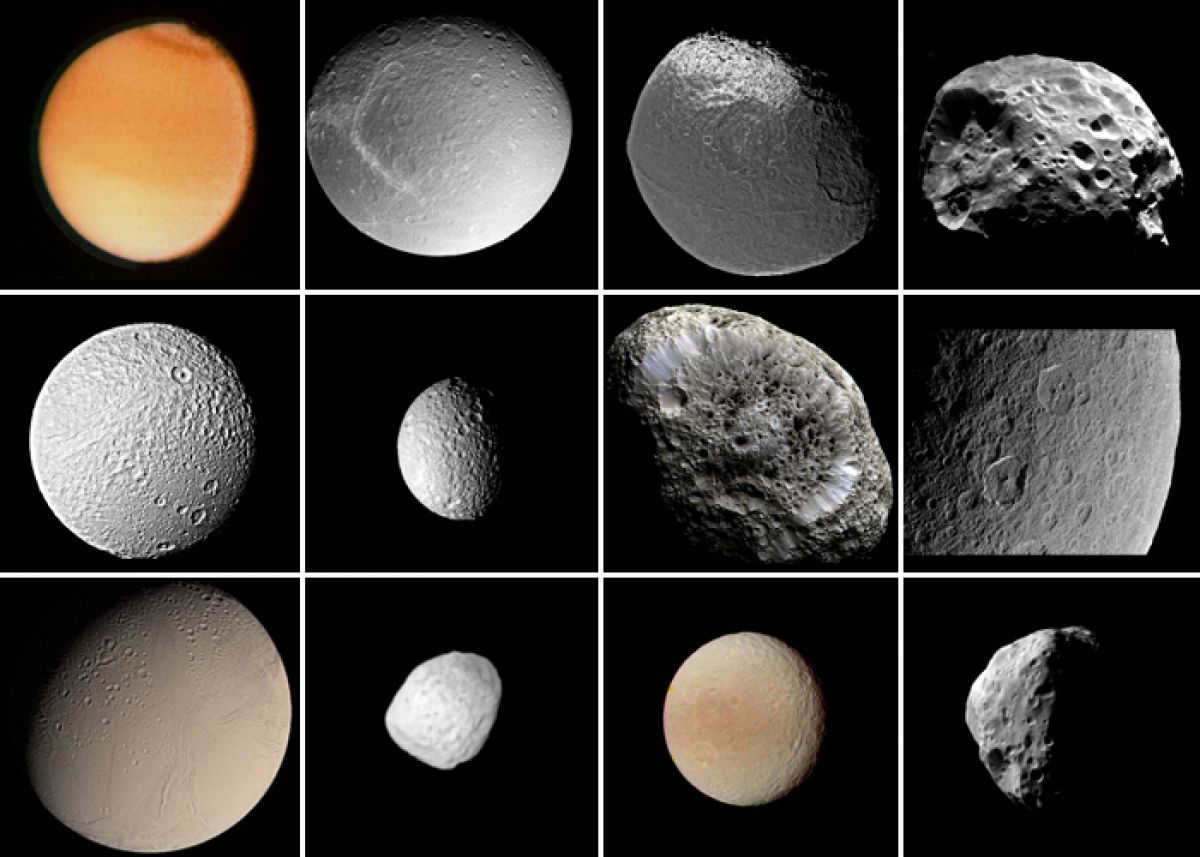

The Rings of Saturn
The ring system of Saturn is known for its beauty and is considered the most famous among all known ring systems. Scientists first observed it in 1610. The rings are composed of tiny particles of ice, dust, and other debris. Due to the abundance of ice particles and their ability to reflect light, the rings can be seen from Earth using telescopes.
The rings of Saturn are classified into seven groups, each assigned a specific letter of the English alphabet based on the order of their discovery. Each of these rings is not uniform but consists of thousands of smaller rings. From Earth, groups A, B, and C are visible. However, there is a gap of 4700 kilometers between the first and second group.
The main rings of Saturn are positioned around its equator, approximately 7000 kilometers away. These rings have a radius of 73000 kilometers, but despite their size, each ring is only about a kilometer thick. The generally accepted theory regarding their formation suggests that they were created from the disintegration of a medium-sized moon when it came in close proximity to the planet. The powerful gravitational forces of Saturn pulled the fragments towards it, eventually transforming them into the distinctive rings.
Each of Saturn’s rings has both a bright and a dark side, although only the bright side can be observed from Earth.
Occasionally, the rings may seem to disappear or dissolve. This phenomenon occurs when they align with the Earth’s line of sight, making them appear edge-on and thus invisible.
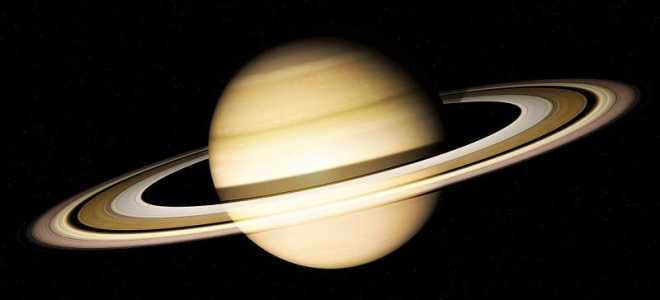

Saturn is the second largest planet in our solar system, both in terms of size and mass. However, when it comes to its distance from the Sun, Saturn ranks sixth. It is worth mentioning that the planet was named after the ancient Roman god of agriculture.
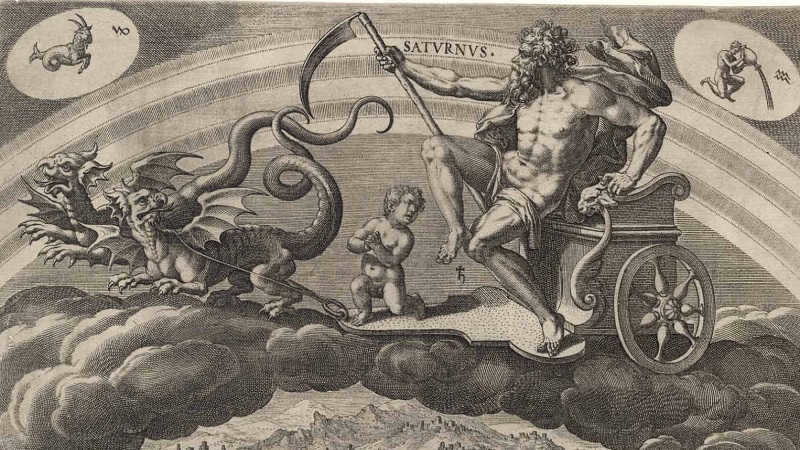

Characteristics of Saturn
As per scientific research, Saturn has an equatorial radius of 60300 km, while at the poles it measures 54400 km. Additionally, its mass is over 85% greater than that of Earth, yet its density is only 0.687 g/cm3, making it the least dense among all the gas giants.
Moreover, Saturn’s internal structure resembles that of other gas giants:
- Firstly, there is a solid and massive core at the center, composed of silicates, metals, and possibly ice. This core has a mass approximately 22 times that of Earth and a temperature of 11700 degrees Celsius. Interestingly, Saturn emits more energy than it receives from the sun.
- Secondly, there is a mantle consisting of metallic hydrogen, which transitions smoothly to the outer region.
- Lastly, the planet is enveloped by a dense gas shell that extends throughout the interior and lacks a distinct boundary with the mantle.
Interestingly, there is no solid surface on this planet or its counterparts.
Atmosphere and Temperature
Similar to other gas giants, the atmosphere of this planet is primarily composed of hydrogen (96.3%) and helium (3.25%). Additionally, there are traces of methane, ammonia, phosphine, ethane, and other gases.
Powerful winds blow in an eastward direction, mirroring the planet’s axial rotation. These winds can reach speeds of up to 500 m/s, although they weaken the further they are from the equator. Moreover, the wind currents in the northern and southern hemispheres seem to be interconnected and proportional to their distance from the equator.
Sometimes, incredibly powerful hurricanes and auroras form in the solar system, unlike anything seen before. Additionally, there are storms accompanied by the most intense lightning.
Interestingly, an extraordinary enormous cloud formation known as the hexagon hexagon (a six-sided regular polygon) has been discovered at the North Pole. It is significantly larger than Earth in size and rotates for a duration of 10 hours and 39 minutes, corresponding to the period of radio emission intensity change and the rotation time of the planet’s inner core. Scientists have yet to provide a precise explanation for this phenomenon.
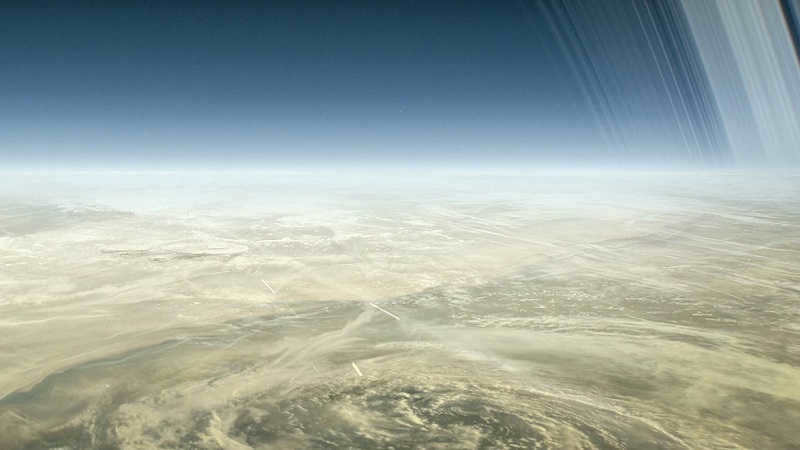

The average temperature of this gas giant is -185 degrees Celsius, making it significantly colder than our home planet. To put this into perspective, the lowest recorded temperature on Earth’s surface was -89.2 degrees. So, Saturn’s temperature is much lower compared to our planet.
Orbit and rotation
Firstly, the distance between the primary star and Saturn was calculated, which has an average value of 1430 million kilometers. Additionally, it takes Saturn 29.5 years to complete one revolution around the Sun, with an average speed of movement of 9.69 km/s. Furthermore, the distance between Saturn and Earth was determined, ranging from 1195 to 1660 million kilometers.
Saturn completes a full rotation on its axis in 10 hours, 34 minutes, and 13 seconds. Interestingly, the speed of rotation is higher at the equator compared to its orbit. Observations of radio emissions have indicated that the duration of rotation varies in different regions of the planet. For instance, the inner parts rotate faster by approximately 30 seconds compared to the belts. This discrepancy is likely influenced by the eccentricity of Saturn’s orbit, which is 0.056.
Satellites
In 2019, there were a total of 82 known natural satellites whose orbits have been confirmed. The majority of these satellites exhibit synchronous rotation, meaning that they always present the same side to the planet.
Furthermore, the largest satellite in the entire system, Titan, is the second largest overall, coming after Ganymede. Noteworthy among Saturn’s larger satellites are Dione, Mimas, Tethys, Rhea, Enceladus, and Iapetus. These satellites are actively being researched by scientists.
Additionally, a recent discovery has revealed the existence of another 20 satellite objects orbiting in a retrograde orbit. These objects are still undergoing extensive study.
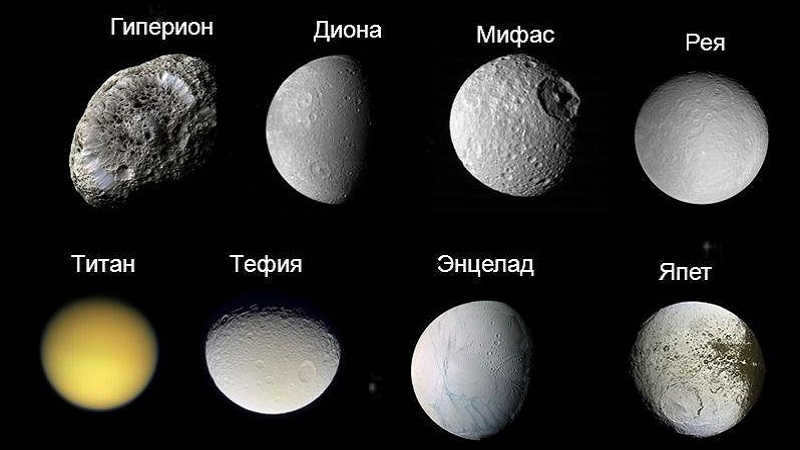
Rings of Saturn
Saturn possesses the most prominent and easily visible ring system among all the planets. It is composed of a total of 13 rings. These rings are inclined at an angle of 28 degrees to the ecliptic plane, which means that they appear differently to observers on Earth at different times. At certain times, the rings may be fully visible, while at other times, only a narrow portion of them can be observed. The rings themselves are made up of countless tiny particles that orbit close to the planet. These particles are primarily composed of ice and carbon.
First and foremost, it is important to differentiate between the three primary rings (A, B, and C) and the thinner one. These rings, collectively, reflect more light than the planet’s own disk. It should be noted that the rings have a diameter of approximately 250,000 kilometers, but they are rather thin, measuring no more than a kilometer in thickness. Based on images captured by spacecraft and probes, scientists have concluded that the rings are composed of thousands of individual rings with gaps between them.
In addition, scientists have also observed oscillations in the rings. These oscillations are likely caused by ongoing disturbances within the rings, such as particle interactions and the influence of the satellite Mimas.
According to current theories, the rings formed as a result of the demise of a liquid satellite. One hypothesis suggests that tidal forces led to its destruction, while another proposes that it collided with a comet or an asteroid.
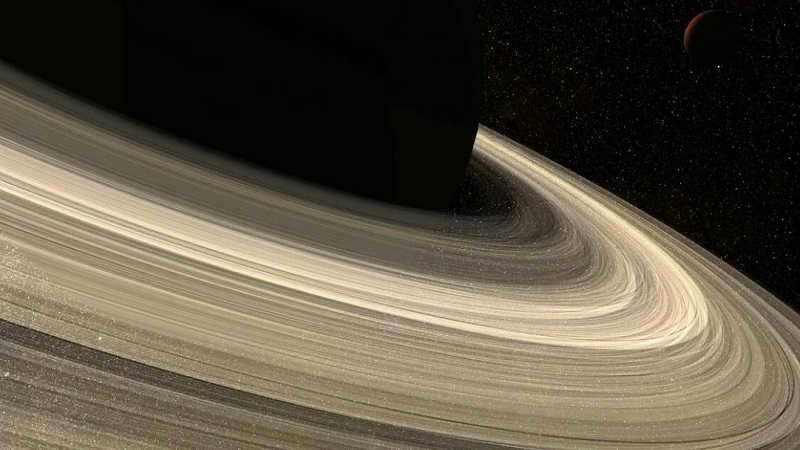

Fascinating information
- Within the depths of its atmosphere, there is a rise in pressure and temperature, leading to the transformation of hydrogen into a liquid state, eventually becoming metallic.
- The observable atmosphere of Saturn is relatively tranquil, maintaining a sense of equilibrium and rarely giving rise to any enduring phenomena.
- The planet’s magnetic field is thought to be generated by the circulation of electric currents, albeit weaker than that of Jupiter.
- Furthermore, within its magnetosphere, there exists plasma originating from the planet itself as well as its satellite objects.
- The acceleration due to gravity on Saturn is 10.44 m/s2, which is comparable to Earth and Neptune, but lower than that of Jupiter.
- Saturn is notable for having the highest number of moons among all known celestial objects. While Earth has only one natural satellite, Saturn boasts a total of 62 moons!
- Notably visible from Earth, Saturn is the most distant planet that can be observed with the naked eye. Its apparent stellar magnitude ranges from -0.24 to +1.47.
While Saturn has been known to humanity for a long time due to its prominence in the celestial sphere, its in-depth exploration began with the use of spacecraft. The renowned Hubble telescope and spacecraft like AMS Pioneer-11, Voyager 1 and 2, and Cassini-Huygens have played crucial roles in studying Saturn. The data collected from these missions have provided valuable insights into the planet and its moons.

